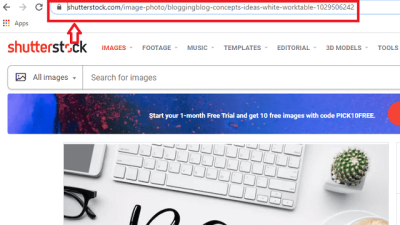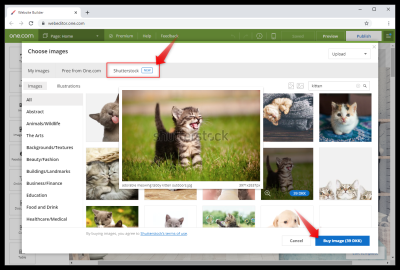If you’ve ever wondered how talented photographers, graphic designers, or artists turn their creativity into a steady income, Shutterstock might just be the platform for you. As one of the largest stock photo marketplaces, Shutterstock offers an exciting opportunity to showcase your work and earn money whenever someone downloads your images, videos, or illustrations. Whether you’re a hobbyist looking to monetize your passion or a professional aiming for a new revenue stream, understanding how to navigate
Understanding the Shutterstock Contributor Program
The Shutterstock Contributor Program is your gateway to earning money through your visual content. Once you sign up and get approved, you become a contributor, gaining access to upload and license your work to millions of potential customers worldwide. Here’s a quick rundown of how it works:
- Application and Approval: First, you’ll need to submit an application showcasing your portfolio. Shutterstock reviews your submissions to ensure they meet quality standards. Once approved, you can start uploading.
- Uploading Content: Upload high-quality images, videos, vectors, or illustrations. Be sure to adhere to Shutterstock’s content guidelines to increase your chances of acceptance and sales.
- Keywording and Metadata: Properly keyword your assets to make them easily discoverable. Think like a customer searching for specific visuals—use relevant, descriptive tags.
- earning Royalties: When someone downloads your content, you earn a royalty fee. The amount varies depending on your contributor level, the type of content, and the licensing option chosen by the buyer.
Shutterstock’s revenue model is designed to reward quality and consistency. As you submit more content and gain sales, your contributor level can increase, unlocking higher royalty rates. Plus, the platform provides stats and analytics to help you understand what’s working and where to focus your efforts. Overall, the program is straightforward but requires dedication to produce and upload high-quality content regularly. With patience and persistence, many contributors turn Shutterstock into a reliable income stream.
Creating High-Quality and Marketable Content
When it comes to making a living on Shutterstock, one of the most important steps is consistently creating content that’s both high-quality and marketable. Think of your images as products in a store—you want them to stand out, look professional, and appeal to a wide audience.
First off, focus on technical excellence. This means sharp images, good lighting, and proper exposure. Blurry or poorly lit photos tend to get passed over quickly. Use a good camera or smartphone with a high-resolution sensor, and always review your shots before uploading.
Next, consider what’s trending and in demand. Browse Shutterstock’s popular categories—like business, lifestyle, nature, or technology—and see what types of images are getting lots of downloads. Creating content aligned with current trends can boost your visibility and sales.
But don’t just chase trends blindly. Authenticity matters! People love real, relatable images—candid shots, diverse models, and natural settings often perform better than overly staged or cliché stock photos.
Here are some tips for creating marketable content:
- Focus on versatility: Capture images that can be used in multiple contexts, such as business meetings, casual work environments, or outdoor activities.
- Use models thoughtfully: If you include people, ensure diversity and natural expressions. Obtain model releases when needed.
- Pay attention to composition: Follow basic principles like the rule of thirds, leading lines, and avoiding distracting backgrounds.
- Keep backgrounds simple: Clean, uncluttered backgrounds help your subject stand out and make the image more adaptable.
- Offer variety: Shoot from different angles, perspectives, and lighting conditions to give buyers more options.
Lastly, don’t forget to edit your photos. Basic adjustments—like brightness, contrast, and color correction—can make a big difference. Use editing tools like Lightroom or Photoshop, but keep edits natural-looking. Overdone filters can turn off buyers looking for authentic images.
Optimizing Your Images for Better Visibility and Sales
Creating great content is just the first step. To actually make sales, your images need to be easily discoverable. That’s where optimization comes into play. Think of it as setting up your images so they show up in the right searches and attract the right buyers.
Shutterstock relies heavily on keywords, titles, and descriptions to categorize and display your images. So, investing time in optimizing these elements can significantly increase your visibility.
Here are some practical tips for optimizing your images:
- Use descriptive, relevant titles: Make your titles clear and specific. Instead of “Photo1,” try “Businesspeople in Meeting with Laptops”.
- Write detailed descriptions: Explain what’s happening in the image, including relevant details like location, mood, and potential uses.
- Choose accurate keywords: Add a mix of broad and niche keywords. Think about what buyers might search for—“remote work,” “team collaboration,” “healthy eating,” etc.
Some additional tips include:
- Don’t overstuff keywords: Use relevant keywords naturally. Avoid spammy practices—quality over quantity.
- Prioritize important keywords first: The first few keywords carry more weight in searches, so place the most relevant ones upfront.
- Use all available keywords: Shutterstock allows up to 50 keywords per image. Utilize all slots thoughtfully to maximize visibility.
- Consistently update metadata: If you notice certain keywords aren’t performing well, tweak them. Keep your metadata fresh and relevant.
Another way to boost visibility is by choosing the right categories and collections. Assign your images to relevant categories so they appear in curated galleries or themed searches.
Finally, pay attention to your image file names. Use descriptive filenames like professional-team-meeting.jpg instead of random strings. Search engines and Shutterstock’s internal algorithms can pick up on these clues to improve your image’s ranking.
In summary, creating top-notch content combined with smart optimization can dramatically increase your chances of making sales on Shutterstock. Keep learning, stay updated on trends, and continually refine your approach—your efforts will pay off over time!
Strategies for Growing Your Portfolio and Audience
Building a robust portfolio and attracting a steady audience on Shutterstock can feel like a daunting task at first, but with the right strategies, you’ll find yourself gaining momentum faster than you think. Think of your portfolio as your storefront — the more appealing and diverse it is, the more customers will be drawn to it.
First, focus on consistency and quality. Regularly uploading high-quality images, vectors, or videos keeps your portfolio fresh and engaging. Quality always trumps quantity, so take your time to ensure each submission is well-composed, well-lit, and relevant. When you upload consistently, Shutterstock’s algorithms tend to favor your content, making it more visible to potential buyers.
Next, consider diversifying your content. Don’t put all your eggs in one basket. Cover a wide range of popular themes, such as business, technology, lifestyle, nature, and seasonal topics. Use trending keywords and current events to tap into high-demand areas. This not only broadens your audience but also increases the chances of your work being discovered.
Another key strategy is to engage with the community. Participate in forums, share your insights, and learn from other successful contributors. Many platforms have thriving communities where you can exchange tips, get feedback, and stay updated on what’s trending. Also, pay attention to what top contributors are doing — analyze their portfolios and see what works for them.
Don’t forget about SEO optimization. Use relevant, descriptive keywords, titles, and tags for each submission. Think about what buyers might search for and incorporate those terms naturally. This improves your content’s discoverability and can significantly boost downloads.
Lastly, keep an eye on analytics and feedback. Shutterstock provides insights into which images are performing well. Use this data to understand your audience’s preferences and refine your future uploads accordingly. Over time, you’ll develop a keen eye for what sells and can tailor your portfolio for maximum growth.
Tips for Increasing Your Earnings and Achieving Financial Goals
Making a living on Shutterstock isn’t just about uploading pretty pictures — it’s about smart strategy, consistency, and understanding your income streams. Here are some practical tips to help you boost your earnings and reach your financial goals.
First, maximize your portfolio’s potential by focusing on high-demand, high-earning niches. Stock images related to business, technology, health, and lifestyle tend to sell more frequently. Keep an eye on trending topics and seasonal needs; for example, holiday-themed content during festive seasons always does well.
Second, consider pricing strategically. While Shutterstock sets standard royalty rates, you can influence your earnings by uploading exclusive content or participating in special promotions. Also, creating exclusive content can lead to higher royalties, as some buyers prefer unique assets.
Third, increase your upload frequency. The more content you have, the higher your chance of sales. However, always prioritize quality over quantity. Consistent uploads keep your portfolio active and improve your visibility in searches.
Another powerful tip is to bundle your assets. For example, offer collections or sets of related images. Buyers often prefer to purchase bundled content for convenience, which can translate into higher earnings per sale.
Additionally, use analytics to your advantage. Review which types of content generate the most income and double down on those areas. Adjust your future uploads based on what’s working best. Keep testing and refining your approach.
Lastly, set clear financial goals and track your progress regularly. Break down your annual or monthly income targets into actionable steps. Celebrate milestones, like reaching a certain number of downloads or earnings, to stay motivated. Remember, building a sustainable income on Shutterstock takes patience and persistence, but with the right mindset and strategies, you can turn your creative passion into a steady revenue stream.
Common Challenges and How to Overcome Them as a Shutterstock Contributor
Jumping into the world of stock photography and videos on Shutterstock is exciting, but it’s not without its hurdles. Many contributors face similar challenges along the way, so knowing how to tackle them can make your journey smoother and more successful.
1. Standing Out in a Crowded Marketplace
Shutterstock hosts millions of images, which can make it tough for your work to get noticed. To stand out, focus on creating high-quality, unique content that fills gaps in popular categories. Research trending themes and niche markets, and develop a consistent style that reflects your strengths.
Tip: Use keyword research tools to identify what buyers are searching for and tailor your uploads accordingly.
2. Managing Rejections and Low Performance
Rejections can be disheartening, but they’re part of the process. Review Shutterstock’s content guidelines carefully and compare your submissions to top-performing files. Sometimes, minor tweaks—like adjusting composition or enhancing image quality—can turn a rejected file into a bestseller.
Solution: Keep a record of rejections to identify patterns and improve your future submissions. Patience and persistence are key!
3. Staying Consistent and Motivated
Uploading regularly can be challenging, especially when motivation dips. Set achievable goals—like uploading a certain number of files each week—and create a schedule. Celebrate small wins to keep your enthusiasm high.
Pro Tip: Join online communities or forums for Shutterstock contributors. Sharing experiences and getting feedback can boost your motivation and provide valuable insights.
4. Navigating Licensing and Copyright Issues
Ensuring that all your content complies with legal standards is crucial. Avoid including recognizable people, private property, or copyrighted brand logos without proper releases. When in doubt, seek legal advice or use royalty-free or public domain resources.
Remember: Being diligent about licensing protects you from potential legal issues and preserves your reputation as a trustworthy contributor.
Additional Resources and Tools to Boost Your Success
Want to give your Shutterstock journey a boost? There are plenty of resources and tools out there designed to help you improve your skills, optimize your content, and stay inspired.
1. Keyword Research Tools
- Google Keyword Planner – Find popular search terms related to your niche.
- Shutterstock Contributor Dashboard – Offers insights into trending keywords and categories.
- Keyword Tool Dominator – Helps generate relevant tags for your files.
2. Editing and Enhancement Software
- Adobe Photoshop & Lightroom – For professional editing and color correction.
- GIMP – Free alternative for editing images and graphics.
- DaVinci Resolve – Powerful free tool for video editing.
3. Learning Platforms and Courses
- Skillshare – Offers courses on photography, editing, and more.
- Udemy – Wide range of tutorials on stock photography and video production.
- Photography Life – Tips and articles to improve your craft.
4. Community and Support Groups
- Join forums like Shutterstock Contributor Forums for peer support and advice.
- Facebook groups dedicated to stock photography and videography.
- Reddit communities such as r/stockphotography.
5. Tracking and Analytics Tools
- Use the Shutterstock Contributor Dashboard to monitor your sales and views.
- Consider spreadsheet trackers or tools like Airtable to organize your uploads and performance data.
Leveraging these resources can help you refine your craft, increase your visibility, and ultimately boost your earnings. Remember, continuous learning and adaptation are part of the process. Keep experimenting, stay inspired, and don’t be afraid to try new things!



